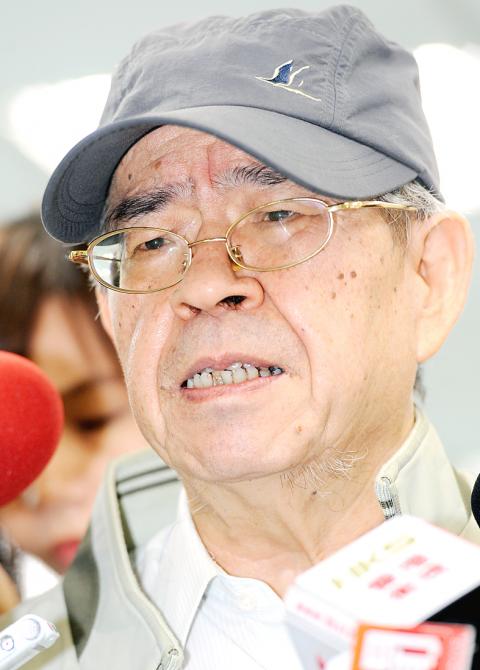Political analysts and Democratic Progressive Party (DPP) politicians yesterday criticized President Ma Ying-jeou (馬英九) for describing cross-strait relations as not international and cross-strait flights as domestic flights.
“What Ma has been doing in the past five years, in terms of external relations, is lying. He lied to the Taiwanese, the US and Beijing, hoping to reap benefits and personal gains,” political commentator Nan Fang Shuo (南方朔) said on the sidelines of a DPP-organized forum in Taipei.
At the Chinese Nationalist Party’s (KMT) weekly Central Standing Committee meeting on Wednesday, Ma, noting that domestic flights in the US have been more profitable than international flights, said that Taiwan’s airline companies would not have been profitable if they were not operating cross-strait routes.

Photo: Lo Pei-der, Taipei Times
“The relations between Taiwan and China are exactly like that,” Ma was quoted as saying.
His comment was interpreted to mean that cross-strait flights are domestic flights.
Ma also drew fire with his Double Ten National Day speech on Oct. 10 when he said the cross-strait relations were not international relations.
The Ma administration’s handling of diplomatic affairs has failed to maximize Taiwan’s gain and minimize potential damages, Nan Fang Shou said, adding that Ma assumed his deceit would win him an opportunity to meet Chinese President Xi Jinping (習近平) at next year’s APEC summit in Beijing.
Asked if Ma’s recent comments underlined the necessity for a constitutional amendment, Nan Fang Shuo said that the true problem did not lie in the Constitution, but in the way Ma and the KMT distorted the Constitution.
“If someone could distort the Constitution like that, amending the Constitution would not be meaningful,” he said.
Meanwhile, Ma yesterday tried to dismiss concerns about his defining cross-strait ties as “not international relations.”
“The Republic of China [ROC] is a sovereign country, and mainland China is part of our territory according to the Constitution. Therefore, our relations with the mainland are not international relations. It is a special relationship,” he said at a meeting with a US delegation led by Wyoming Governor Matt Mead at the Presidential Office.
The president also reiterated his “three noes” policy of no unification, no independence and no use of force in handling cross-strait relations, and said that the government continued to promote cross-strait development under the so-called “1992 consensus.”
He said that cross-strait air routes are neither international flights nor domestic ones, shrugging off concerns about his comparison of US domestic flights to cross-strait flights.
“We’ve defined that the cross-strait air routes are not international ones or domestic ones. They are special flights,” he said.
“Such a definition allows the two sides of the Taiwan Strait to enhance their relations and bring profits to the people from both sides that they did not enjoy in the past,” he said.
Ma cited the signing of the Economic Cooperation Framework Agreement (ECFA) and the service trade agreement, and said the cross-strait relations are the most peaceful and stable they have been in the past 60 years.
He also said the nation will continue to seek cooperation with the US in maintaining a sustainable defense force to protect public safety.

The US government has signed defense cooperation agreements with Japan and the Philippines to boost the deterrence capabilities of countries in the first island chain, a report by the National Security Bureau (NSB) showed. The main countries on the first island chain include the two nations and Taiwan. The bureau is to present the report at a meeting of the legislature’s Foreign Affairs and National Defense Committee tomorrow. The US military has deployed Typhon missile systems to Japan’s Yamaguchi Prefecture and Zambales province in the Philippines during their joint military exercises. It has also installed NMESIS anti-ship systems in Japan’s Okinawa

‘WIN-WIN’: The Philippines, and central and eastern European countries are important potential drone cooperation partners, Minister of Foreign Affairs Lin Chia-lung said Minister of Foreign Affairs Lin Chia-lung (林佳龍) in an interview published yesterday confirmed that there are joint ventures between Taiwan and Poland in the drone industry. Lin made the remark in an exclusive interview with the Chinese-language Liberty Times (the Taipei Times’ sister paper). The government-backed Taiwan Excellence Drone International Business Opportunities Alliance and the Polish Chamber of Unmanned Systems on Wednesday last week signed a memorandum of understanding in Poland to develop a “non-China” supply chain for drones and work together on key technologies. Asked if Taiwan prioritized Poland among central and eastern European countries in drone collaboration, Lin

NO CONFIDENCE MOTION? The premier said that being toppled by the legislature for defending the Constitution would be a democratic badge of honor for him Premier Cho Jung-tai (卓榮泰) yesterday announced that the Cabinet would not countersign the amendments to the local revenue-sharing law passed by the Legislative Yuan last month. Cho said the decision not to countersign the amendments to the Act Governing the Allocation of Government Revenues and Expenditures (財政收支劃分法) was made in accordance with the Constitution. “The decision aims to safeguard our Constitution,” he said. The Constitution stipulates the president shall, in accordance with law, promulgate laws and issue mandates with the countersignature of the head of the Executive Yuan, or with the countersignatures of both the head of the Executive Yuan and ministers or

Renewed border fighting between Thailand and Cambodia showed no signs of abating yesterday, leaving hundreds of thousands of displaced people in both countries living in strained conditions as more flooded into temporary shelters. Reporters on the Thai side of the border heard sounds of outgoing, indirect fire yesterday. About 400,000 people have been evacuated from affected areas in Thailand and about 700 schools closed while fighting was ongoing in four border provinces, said Thai Rear Admiral Surasant Kongsiri, a spokesman for the military. Cambodia evacuated more than 127,000 villagers and closed hundreds of schools, the Thai Ministry of Defense said. Thailand’s military announced that